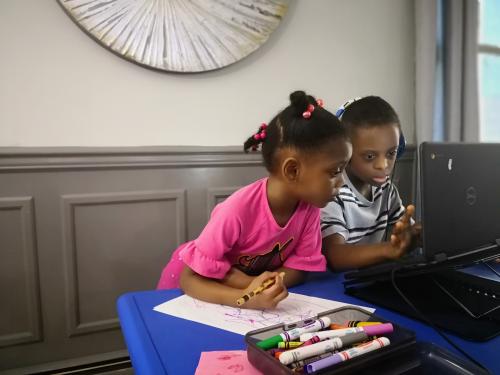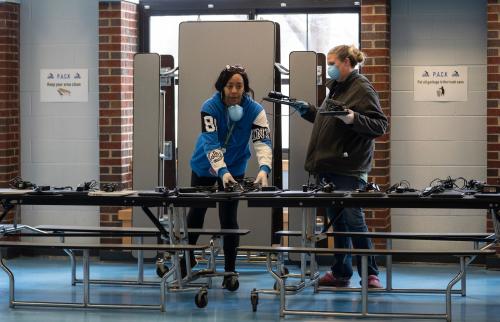This is the first of three blog posts focusing on why Congress should invest more in broadband connectivity for schools so that reopening can be safe for students and support continuous learning. The second blog post will offer what every school should include in a 21st century remote access plan. The final blog post of the series will explore the role of community anchor institutions in covering the blind spots for school districts that are seeking creative ideas to close local digital gaps among their students.
The reopening of schools has become contentious with the White House and the Department of Education’s threats to pull funding for public schools that stay closed. The state of Florida, one of the latest coronavirus hot spots, is planning to bring K-12 students back for in-person instruction in early August. In July, Florida’s governor issued an emergency order requiring such action, despite the state’s increased surge in the novel coronavirus, or COVID-19, infections, but state educators have responded with lawsuits to stop the governor’s plan.
Last May, the Centers for Disease Control (CDC) issued school reopening guidelines, which were updated to allow for students to return in person after pressure from the White House. Still, millions of K-12 students may still find themselves at home without available testing to mitigate the spread of COVID-19. Schools that choose to physically open will be challenged to keep students, faculty and other staff safe, while potentially imposing mandatory quarantines if one person falls ill. Three months ago, Israel reopened their schools with fewer than 300 cases in the country. Within one month, more than 2,000 students, teachers, and staff were infected, and now over 28,000 people are under some type of government-mandated quarantine.
Many school districts have announced plans to either go completely virtual or implement a hybrid model of both in-person and distance learning. But if the last few months are any indication of most schools’ effectiveness in deploying remote learning, minority and rural students, especially those from impoverished public schools, will lose the race to educational and social mobility outcomes. Students with special learning needs or English language learners will also be affected without a one-to-one connectivity solution. One California study found that of the counties where school-age children had the highest share of special learning needs, over 18 percent of their households lacked broadband access.
Given these new realities, every K-12 school must have a 21st century remote access plan to complement the CDC guidance and Congress must direct the necessary funding for bringing broadband access to all public schools in the next coronavirus stimulus bill. To make distance learning work, vulnerable families need emergency broadband relief, which can be done through increased investments in home broadband, schools, and libraries.
What the beginning of the pandemic taught us about remote learning
Over the last few months, the nation has seen how important it is to be connected as stores, schools, businesses and other major institutions shut down. More than 22 years ago, the term “digital divide” was created to describe the pernicious effects of not being connected. In 2010, the Federal Communications Commission (FCC) laid out a similar argument in the inaugural National Broadband Plan.
Years later, current FCC Commissioner Jessica Rosenworcel introduced the term “homework gap” to explain the obstacles for educational achievement among school-age children without broadband access. Former President Barack Obama championed digital equity for schools and libraries as part of the national ConnectEd program that vowed to bring high-speed broadband to 99 percent of these institutions.
Nevertheless, COVID-19 has revealed that the emperor is still without clothes as more than 12 million of 55 million students who were sent home at the end of March did not have home broadband access. Parents and educators found themselves in the parking lots of libraries, schools, and open business establishments to use their public Wi-Fi networks.
Recent research on distance learning found that nine million students in the U.S. did not have access to both internet and a device to use as schools transitioned to online learning. In another recent survey of device accessibility, low-income African Americans, Latinos, and first-generation college students were also more likely to have only one device within the home to be shared among multiple siblings.
The largest school districts in the country including Los Angeles County Unified School District and New York City Public schools cancelled the remainder of the school year after temporary closures in March. For the upcoming school year, LA County schools will remain closed until the virus can be effectively mitigated.
These and other accounts point to the combined failures of government and the private sector to close the digital divide before now. And without the support of Congress, more vulnerable students will get left behind in the forthcoming school year.
School reopening needs consistent broadband
As expected, President Trump is distracting from a real conversation on school reopening by asking for Congress to appropriate $105 billion into the next coronavirus stimulus bill for school choice, money that he has stated should allow parents to send their K-12 children back into a physical building. Without exploring the direct health consequences, the president’s proposal panders to the current frustration of parents who are wedged between their aspirations of rigid public health oversight in schools, and the realities of a virus spreading unchecked until a vaccine becomes available.
The appropriation request also saps energy from prior legislative drafts that have called for broadband funding to schools and communities, such as the funding integrated into the HEROES Act that was passed by the House in May. Currently, Congress is discussing the inclusion of approximately $70 billion in funding to K-12 schools in the next stimulus bill. It is still unclear how the aid will be distributed and at what level – federal, state, or local — and if schools physically reopening will be a requirement for the funding. With the road to educational recovery requiring broadband access, the prioritization of this area is crucial to how schools navigate the upcoming school year.
Three things Congress must include to reopen schools
As Congress debates how to navigate economic recovery for businesses, families and individuals, Members should also consider the following types of relief toward students, whose interrupted learning can also have a long-term detrimental effect on the nation’s future industries. In particular, previous broadband legislation, including elements that were dismissed from the previous HEROES Act, could be useful starting points.
Expand broadband subsidies
Families need emergency broadband relief to stay connected. During the May negotiations of the HEROES Act, Congressman Marc Veasey (D-TX) introduced the Emergency Broadband Benefit (EBB), which could keep the most vulnerable households connected to broadband service, especially those families with school-age children who require connectivity. As previously outlined, the EBB would include a $20-$50 subsidy for individuals already eligible for the FCC Lifeline program and other public benefit services (e.g., SNAP, Medicaid, SSI). The subsidy would be reimbursed to internet service providers, who demonstrated some commitment to closing the digital divide through the FCC’s #KeepAmericansConnected pledge. More than 800 providers relaxed and temporarily stopped service interruptions and data caps for subscribers impacted by COVID-19. The EBB could have a similar impact on vulnerable populations, provided Congress is willing to invest the $8.8 billion dollars proposed for its operation.
Update E-Rate to support home broadband access
The federal E-rate program needs to be fully invested and expanded to support schools and libraries’ home broadband access for eligible students. When Ed Markey (D-MA) established the E-rate program in 1996, it was designed to support discounted broadband to schools and libraries for “educational purposes.” Last March, the Coronavirus Aid, Relief, and Economic Security (CARES) Act included $16.5 billion for states and school districts (including E-Rate support), but many are arguing that it’s going to take upwards of $100-250 billion to effectively tackle the digital divide that will impact schools into the fall. Moreover, the first wave of money did not address the specific statutory and economic shortfalls in the current federal E-Rate program. During the pandemic, 18 Senate Democrats, a coalition of 7,664 education leaders, and various civil society groups are asking for a modernization. The FCC argues that its statutory authority is limited to schools and libraries, but Congress can immediately change the restrictive language and redirect some of the unused support to home broadband access. Changing the statute and increasing funding more could transform “digital parking lots” into “digital parks” and other connected public spaces that can help reduce the density of classroom gatherings overnight.
Fund grant programs for community broadband development
Congress should appropriate funding to local communities to fill in the “blind spots” of broadband connectivity for schools. The last few months have been a national pilot for accelerating broadband access to students via Wi-Fi-enabled school buses, loaned wireless hot spot devices, and mesh networks in public housing. However, schools have had to be creative in funding these types of programs, as well as assuming roles as broadband engineers in their race to connect their districts.
In 2019, Representative Patty Murray (D-WA) introduced the Digital Equity Act, which offers some ideas for funding local digital inclusion efforts. To ensure that schools have the bandwidth to develop the local digital infrastructure of their communities, Congress could appropriate funds toward a competitive grant or formula-based allocations to local organizations focusing on digital literacy, online accessibility, local mapping, and technology adoption programs for vulnerable urban and rural populations. In the Digital Equity Act, they established the threshold of that fund to be an annual $120 million formula grant program for all 50 states, including D.C. and Puerto Rico, which could be administered by the National Telecommunications and Information Administration (NTIA). As the next (and potentially final) coronavirus stimulus bill is developed, the support of digital inclusion projects and organizations that can help schools mobilize their local communities around connectivity would facilitate student access.
Closing the national digital divide is going to take a herculean effort before the start of the new school year. But if the last few months have been a lesson, schools cannot take on the task of connecting their students, homes, and communities by themselves, which is why Congress needs to prioritize the needs of students and their online access in the next round of stimulus funding.
The author would like to thank Mishaela Robison for her research assistance with this blog post.










Commentary
For schools to reopen, Congress must include broadband funding in the stimulus bill
July 28, 2020